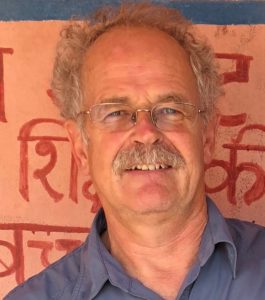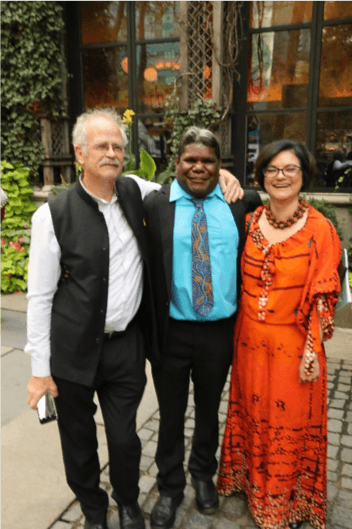Reflections – sustainability and human rights focus
 David Hircock, Executive Director, Corporate Affairs Global Communications, Estée Lauder Companies, has worked extensively around the globe as a respected expert on issues related to human rights, conservation of biodiversity and working with Indigenous Peoples. His work is particularly related to the supply chains of raw materials and services.
David Hircock, Executive Director, Corporate Affairs Global Communications, Estée Lauder Companies, has worked extensively around the globe as a respected expert on issues related to human rights, conservation of biodiversity and working with Indigenous Peoples. His work is particularly related to the supply chains of raw materials and services.
The UN General Assembly as usual was crazy, busy, fascinating and oftentimes frustrating, yet with a little planning and some luck and working with the best people, one can work with others to achieve positive ways forward. Our work during the General Assembly was based on long term relationships where the communities we work with had either been given major UN and International Awards or were given a platform at the UN to speak on their work and challenges.
For more background on the project, especially on its significance to the Kutkabubba community, see the video produced about the project, Dutjahn Sandalwood Oils & The Estée Lauder Companies: Creating a Beautiful Future Together.
Australian Sandalwood* – access to sustainable resources in the Gibson Desert – Nature Based Cultural Economy
By David Hircock
This year, Dutjhan Sandalwood Oils (DSO) were named a recipient of the United Nations Development Programme’s Equator Prize, an award that recognizes outstanding local community and indigenous initiatives that are advancing nature-based solutions for climate change and local sustainable development. A ceremony in New York City on Tuesday, September 24. 2019 celebrated DSO and 21 other local communities from around the world who won this award.
The Estee Lauder Companies have worked with the Kutkabubba community for over 15 years working to source a sustainable source of sandalwood for perfumery use. There have been many challenges, from obtaining legal access to this resource from their lands and the allied revenue that could be gained from this, once they gained increased access from Australian regulatory bodies.
Dutjahn Sandalwood Oils is an innovative partnership involving the Kutkabubba aboriginal community in Western Australia. DSO Pty Ltd produces sandalwood oil for export to the global luxury perfume market. The partnership provides a unique avenue to create a value-added product from sandalwood, a sacred plant for the Kutkabubba and a key part of the spiritual identity of the Central Desert Aboriginal tribes.
This innovative economic model is redefining how society can engage with aboriginal communities in Western Australia by providing both industry and governments with a best practice approach for natural product sustainable supply chains. By embracing sustainable harvesting, valorizing traditional knowledge and cultural practices, and ensuring socioeconomic independence for the Kutkabubba aboriginal community, Dutjahn Sandalwood Oils provides a powerful new economy model for sustainable development.
Nature-Based Cultural Economy
Due to a Western Australian government limited license from the Department of Biodiversity, Conservation and Attractions (DBCA), the Kutkabubba Aboriginal Community, whose people have Title to their lands, were unable to sustainably harvest Australian sandalwood from their land in large enough amounts to make a difference to communities other than Kutkabubba through this revenue. Yet in early September the DBCA is now on track to issue a 3-year license to harvest sandalwood in sufficient quantities to enable other communities to gain revenue from working on their lands.
This is enabling their vision for a nature based cultural economy that will open up increased sustainable harvest of Australian sandalwood. This increased revenue will allow more communities to gain work, based on their land and culture. One important area of work will be that this will enable the communities to train and hire local community people to become rangers to care for their land and guide others in its care and longevity.
This is an example of long term partnerships with business and the building of the Australian Sandalwood market with Indigenous Peoples. These partnerships evolved further after several visits by Estee Lauder Companies owned company Aveda in 2005.
Amazon Rainforest – Beacons of Hope – Based on science meeting Indigenous Knowledge to gain a revenue driven model for all Indigenous Peoples in the Amazon
Yawanawa Peoples – State of Acre, Brazil
The Yawanawa Indigenous peoples live in the titled Indigenous Territory of Gregory River, an area of 450,000 acres (178k hectares) of pristine rainforest, in a once very remote area of the Amazon. This is now changing due to the building of roads near to their lands. This brings threats such as predatory fishing and hunting in and around the land, followed by invasions of fishermen and professional hunters, wood exploitation within the indigenous land, driven by the implantation of state forests in its surroundings.
The Yawanawa are particularly unique in their “living on two planets,” one to keep their culture and environment, the second is living in the “modern world” so that they can protect their lands.
A most interesting factor for the Yawanawa is how they are “evolving” under their own terms, without outside influence, yet being aware of outside environments. One “evolution” is that the tribe used to have just one chief and now each of the 7 villages have chiefs, a man and a woman. The women of the village recently also became Shamans as well as chiefs. This was carried out by consultation from their elders and shamans and seen to be part of their journey.
Particularly unique is their development of their Life Plan looking forward a hundred years, as well as their Chief Tashka, almost an Ambassador to the people, travelling the world to advocate for their and other Indigenous Peoples rights.
Not only are the Yawanawa preserving this land for the future of this planet, they are preserving thousands of species of flora and fauna and keeping intact and evolving their medicinal plant knowledge.
This is an example of long term partnerships with business. Aveda, owned by Estée Lauder Companies, first started working with the Yawanawa in 1992 when they met at the first Earth Summit. (Fast Company wrote about this relationship and the role of trust in making it work in a 2010 post, “Aveda and the Yawanawa).
Human Rights in India
Estée Lauder Companies has worked in India for nearly 15 years with Nobel Peace Prize winner Kailash Satyarthi’s team to find solutions for elimination of child labor. During the UN General Assembly, 17-year old youth activist, Payal Jangid, from Hinsla village in Rajasthan, received the ‘Changemaker Award’ from UN Deputy Secretary-General Amina J Mohammed. The Award was presented to Payal for her fight against child labor and child marriage in India.
Payal was recognized for her work towards the abolition of child marriage in her village, Hinsla, which is a child-friendly village (Bal Mitra Gram), and other neighboring villages. In the last census of her village, female literacy was 16.5%. This is now changing because Payal and other children in their village are demanding access to education.
*. A Few Notes on Sandalwood
Sandalwood is one of the world’s most valuable tree species. It’s fragrance, cultural significance, and medicinal properties have put it in high demand for centuries all over the world.[1] Worldwide, populations of various sandalwood species are declining from over harvesting, grazing, and land conversion to sugar cane, pine apple and other crops.[2] But the particular details of these pressures vary depending on the species of sandalwood and the region where it is grown and harvested.
Aveda decided many years ago that they did not want to be involved in the trade of white sandalwood from India (Santalum album). And yet because sandalwood oil was a key ingredient found in many of Aveda’s aroma blends, they needed to find a reliable source. They began partnering with an Australian distiller who in turn worked with the indigenous communities to source Australian sandalwood (Santalum spicatum) from the wild.
[1] S. Leopold. 2012. Hawaiian Sandalwoods and the United Plant Savers “At-Risk” Tool. Conference presentation at the International Sandalwood Symposium. Honolulu, Hawaii.
[2] Subasinghe. 2013. “Feature Article Sandalwood Research: A Global Perspective,” Journal of Tropical Forestry and Environment Vol. 3, No. 01:1-81.




Comments